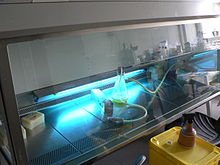.............................................................................................................................................................
How Does UV Light Kill Bacteria?
Written by Tom King
Who Uses UV Light Sterilization
Ultraviolet radiation is used to kill microorganisms, molds and
fungi in various environmental applications.
UV sterilization is used for air-purification systems, water
purification, aquarium and pond maintenance, laboratory hygiene and food and
beverage protection.
When to Use UV Light Sterilization
Ultraviolet sterilization is useful for targeted elimination of
microorganisms in air and water.
UV sterilization leaves no residual chemical or radiation in the
air or water and does not harm untargeted animals and plants
The treatment works well with waterborne pathogens but does not
remove chemical or heavy metal impurities.
Water should be filtered prior to UV exposure to improve the
sterilization effect. Sterilized microorganisms remain in the air or water.
Where to Use UV Light Sterilization
Because direct exposure to strong ultraviolet light can cause
blindness and skin burns to people and animals, sterilization generally takes
place in shielded UV hoods or light-proof UV chambers.
UV treatment works well in applications where bacterial
contamination poses a problem in air or water in aquariums, ponds, laboratories
and clean rooms.
How UV Light Sterilization Works
Ultraviolet light kills microorganisms by damaging their DNA.
UV radiation disrupts the chemical bonds that hold the atoms of
DNA together in the microorganism.
If the damage is severe enough, the bacteria cannot repair the
damage and the cells die.
Prolonged exposure to UV light helps ensure complete kill-off of
all microorganisms.
Unlike chemical treatments, however, UV-treated air or water does
not resist re-contamination.
Why Use UV Light Sterilization
Ultraviolet light penetrates the cells, but does not alter the
water, air or food being treated.
Nothing is added to the medium except energy. Dead bugs also are not removed from the sterilized
medium.
Nor are organic or inorganic particles in the water or air.
Some organisms, like certain molds, are not as affected by UV
radiation.
UV radiation is indicated in situations where chemical residue
after sterilization is not acceptable
The Wrap Up
Ultraviolet radiation is used to kill microorganisms, molds and
fungi in various environmental applications.
UV treatment works well in applications where bacterial
contamination poses a problem in air or water in aquariums, ponds, laboratories
and clean rooms.
Ultraviolet light kills microorganisms by damaging their DNA.
Nothing is added to the medium except energy.
Some organisms, like certain molds, are not as affected by UV
radiation.
Tom King published his first paid story in 1976. His book,
"Going for the Green: An Insider's Guide to Raising Money With Charity
Golf," was published in 2008. He received gold awards for screenwriting at
the 1994 Worldfest Charleston and 1995 Worldfest Houston International Film
Festivals. King holds a Bachelor of Arts in communications from Southwestern
Adventist College.





No comments:
Post a Comment